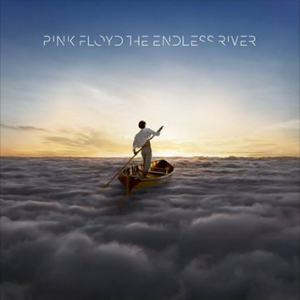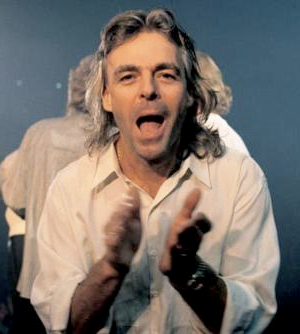2014-11-08
While my guitar gently weeps...

(This is part two of our The Endless River series, for the bawdy introduction, go here: What the fuck is your problem, Pink Floyd?)
So here it is. The Holy Church of Iggy the Inuit's The Endless River review of what undoubtedly is the most anticipated record of the year.
Read
The album has four, mostly instrumental, suites, that Pink Floyd prefers to call sides. Each suite has several tracks, but these are best listened to in one piece as they form one ensemble. The 'luxe' edition has a 39 minutes extra DVD or Blu-ray with 6 videos of 1993 studio rehearsals and 3 audio tracks. The Blu-ray version is the most complete (and expensive) as it also has a stereo PCM, a 5.1 DTS and a 5.1 PCM version of the album, whatever these acronyms mean.
The front cover concept was designed by Ahmed Emad Eldin, in what could be called ersatz Hipgnosis style, probably chosen because it evokes the boatman who was present in The Division Bell artwork (and, in lesser extent, on A Momentary Lapse Of Reason). The other artwork is credited to the usual gang of graphic designers: Aubrey Powell, Stylorouge, StormStudios and, weirdly, Hipgnosis, although that company stopped in 1983. The 24-pages booklet has a maritime feel: compasses, maps, logbooks... The lettering misses a piece in most letters, to accentuate the missing keyboard player, who has been credited on 11 of the 18 tracks. Storm Thorgerson is remembered as well in the credits.

Think
The album was created out of rejected 1993 jams and demos, with Richard Wright, Nick Mason and David Gilmour, that were probably revisited to be added to a Division Bell anniversary set of one kind or another. Rejected is too strong a word because way back, twenty years ago, it had been the idea to turn the The Division Bell into a double CD-set, what was abandoned for lack of time. That second album turned into the apocryphal The Big Spliff that still sits in Gilmour's studio in an unfinished form and that was assembled by Andy Jackson. Phil Manzanera was asked, in 2012, to work on it, but refused.
I don't wanna hear. I wanna hear every single piece or scrap that was recorded, everything. Outtakes from Division Bell. Everything.
In December 2012 Manzanera puzzled dozens of unfinished pieces into a skeleton, divided into four 12 minute suites, out of 20 hours of material. According to Manzanera, Pink Floyd thanked him and immediately put the work in a box where they forgot it. Martin 'Youth' Glover however says that he was invited in June 2013 and that David Gilmour had already worked on the two different versions of the project.
Within about 40 seconds, it sounded like Floyd. It was absolutely magical. (…) Listening to unreleased Pink Floyd recordings with David, the hair was going up on the back of my arms.
Youth then created a third version and in November 2013 a meeting was held between the two remaining Pink Floyd members and the three producers: Andy Jackson, Phil Manzanera and Youth. Gilmour and Mason picked the best ideas from each version and started working on something that could have been an atrocious Frankenmix but that turned out quite coherent in the end.
Listen

Side One: ambient spaces
"Things Left Unsaid...", Gilmour, Wright
"It's What We Do",
Gilmour, Wright
"Ebb and Flow", Gilmour, Wright
Things Left Unsaid (4:27): a very ambient, Cluster One atmospheric, introduction, with some voice samples of the Floyd members. Tradition wants that it only starts morphing into something of a melody after the two minutes mark. It gradually slides into It's What We Do (6:17) that thrives on a Shine On You Crazy Diamond moog synth and traces of Marooned later on. This is a typical Floydian spacey slow blues, ideal for those fans who want to chill out with a big spliff. It's lazy and slow and probably a bit boring for some, a typical trademark of the Floyd sound, and just because it is so intriguingly and deliberately slow, the first thrill of the album. It continues into Ebb and Flow (1:55), mainly an epilogue to the previous track.
Actually the first suite is pretty daring to start with in the hectic days we are living in today, this is so contradictory with contemporary music it nearly feels alienated. It's the kind of suite that will be used in nuru massage parlours around the world.

Side Two: early days tripper
"Sum", Gilmour, Mason, Wright
"Skins", Gilmour, Mason,
Wright
"Unsung", Wright
"Anisina", Gilmour
Sum (4:48), there's that Cluster One intro again with ambient effects switching towards an Astronomy Domine space trip. Then it nods to an early seventies style Floydian jam, One Of These Days, although bigger and louder, including that good old perverted VCS3 machine.
Skins (2:37) further elaborates on the A Saucerful Of Secrets tribal rhythms and this is the first time in years we hear grand vizier Nick Mason take the lead on a track, finally! We could never think we would be so happy with a fucking drum solo. Gilmour makes his guitar scream à la Barrett in Interstellar Overdrive in something that can be described as a beat bolero. The track ends with some minor guitar effects, just for the sake of the effect and glides over to Unsung (1:07), an intermezzo that is a bridge to the ending of this suite, the magical Anisina (3:17). Those who think this is Wright in a jazz lounge must be contradicted. This is 100% Gilmour and it brings shivers down the spine, even if this a known track that has been bootlegged before as a Division Bell outtake.
The second suite is the experimental one, although the experiment is limited not to scare the casual listener away. We've heard people say that this Pink Floyd record is more of the same. And it's true. But who complains when The Rolling Stones or U2 bring out their umpteenth album sounding exactly like the previous one?

Side Three: all that jazz
"The Lost Art of Conversation", Wright
"On Noodle Street",
Gilmour, Wright
"Night Light", Gilmour, Wright
"Allons-Y
(1)", Gilmour
"Autumn '68", Wright
"Allons-Y (2)",
Gilmour
"Talkin' Hawkin'", Gilmour, Wright
The lost art of conversation (1:43) is an introductory piano piece by Wright, obviously with some guitar effects from Gilmour. It segues into On Noodle Street (1:42), that is, as the title gives away, nothing but a light jazzy noodling, featuring Guy Pratt, Wright's son-in-law. It is easy listening for Floydheads, just like the next track Night Light (1:42). The first three tracks are merely the introduction for the highlight of this side, and perhaps the album.
Allons-Y (1) (1:57), is a two-piecer and a Run Like Hell copycat, only much better (actually, we find Run Like Hell one of the worst tracks by the Floyd). It is irresistible and the moment we really started tapping our feet. The mid-piece of Allons-Y is Autumn '68 (1:35), the much discussed archival bit taken from a Wright improvisation from the Royal Albert Hall in 1968, reminding us vaguely of a movement of Mike Oldfield's Tubular Bells, only this dates from about five years before. Allons-Y (2) (1:32) is a reprise of the first part to close the circle.
Talkin Hawkin' (3:29) starts rather like one of those slow evolving (and a bit tedious) pieces from On An Island, but is – yet again – irresistible in its meandering movements. Nobody is so immaculate in creating these lazy and slightly boring moods than Pink Floyd. With its Stephen Hawking samples this track is the obvious link to The Division Bell, but the track itself is the counterpart of Keep Talking.
The third suite is the most light-hearted one, perhaps the most commercial and catchy, and it surely is saved by, here we go, Allons-Y.

Side Four: turn off the lights
"Calling", Gilmour, Moore
"Eyes to Pearls", Gilmour
"Surfacing",
Gilmour
"Louder than Words", Gilmour, Samson
Anthony Moore, who made the Broken China album with Richard Wright is responsible for Calling (3:38) and it certainly has the mood of that pretty depressed, and unfortunately underestimated, album. The atmosphere is somewhat reminiscent of David Bowie's Warszawa, it is an ambient and dark and haunting piece. It is a nice thing from Gilmour to have added this obvious nod to Rick's solo album and one of the more interesting pieces of the album.
Eyes To Pearls (1:51) breathes the air of Angelo Badalamenti's Twin Peaks and has hidden hints of Money and One Of These Days, but one can find traces of earlier work in about all tracks on this album. Didn't Nick Mason quip once he was in the recycling business? Surfacing (2:46) acts as the intro to the final song, it seems a lesser track at first, but it has a weeping guitar that hit us right in the heart / stomach / balls. Actually most of the numbers may not be seen as individual pieces but as movements of each suite and as such they perfectly serve their roles.
Louder Than Words (6:37) was gravely discussed when it came out, it has been called Floyd by numbers and Polly Samson's lyrics are of syrupy soap series quality but in this context and as the coda of the album it just works great. Just listen to that piano intro by Wright, the last we'll probably hear, that irresistible refrain, the perfect ending solo, also the last we'll probably hear... This is Gilmour at his best and for once he doesn't stretches it too long, what was his problem on the previous Diet Floyd records where he had the habit of putting six minute guitar solos in three minute songs. Gilmour's playing on this album is to the point and you never get the feeling he is showing off like on, for instance, On An Island, although it is clear he bought a new set of pedals.
Communicate
This is a great album, a classic in the making, although perhaps only for the die-hard fans, and is far much better than we had ever hoped for.
(A third article, with a more critical approach to the album can be found at: Chin Chin.)
More reviews at A
Fleeting Glimpse and Brain
Damage. Illustrations (except the Rick Wright picture) taken from
The Endless River and The Division Bell..
♥ Iggy ♥ Libby ♥
Sources (other than the above internet links):
Bonner, Michael: Coming
back to life, Uncut, November 2014, p. 35 – 41.

